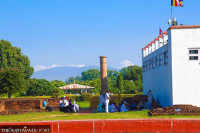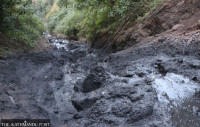Lumbini Province
Villagers unhappy after park takes priority over road
Sisne rural municipality built Rs40 million martyr memorial park in the village, which villagers say does not serve any practical purpose.
Mahesh KC
The locals of Neta in ward 2 of Sisne Rural Municipality have to walk for about two hours along a treacherous narrow trail cut into a cliff to reach the nearest road. The trails become unusable during the monsoon season and biting cold winter months cutting the villagers off from the rest of the local unit.
There is no alternative to this perilous foot trail.
Neta, a geographically locked remote village, badly needs to be connected to the road network, but the local authorities have done little to start building roads to the village. The rural municipality built a martyr memorial park in the village at the cost of Rs40 million which the villagers say does not serve any practical purpose.
“The local authorities know that building a road to connect to the national road network would make our lives easier,” said Ganesh KC of Tiptara in Sisne-2. “But they went ahead and spent money on building a park that does not benefit the locals or add anything to their livelihood.”
“We have to walk through the dangerous trail passing through the cliff. Road construction should be prioritised, but the government allocated a budget to construct the park,” said KC. “It’s not wrong to build a park but that should have been done after our basic needs are met.”
Neta is about 15 km from Rukumkot, the district headquarters. One can reach this remote village through Baluwa in ward 5 of Bhume Rural Municipality. The roadway goes up to Deukhola in ward 14 of Puthauttarganga Rural Municipality in the district. From there, one has to walk three kilometres on a difficult trail to reach Neta.
Instead of giving due priority to road construction, Sisne Rural Municipality and Lumbini provincial government allocated a budget to construct the park. According to Krishna Khadka, the ward 2 chairman, the rural municipality and the provincial government spent Rs20 million each on the park construction. He said that the park construction began in the fiscal year 2018-19 and was completed in 2022-23.
According to Khadka, an old public garden in the settlement was upgraded and named the Martyr’s Memorial Park. A hiking trail of about 500 metres has been built from Tiptara village to reach the park. The park has been constructed on a hilltop with a good view. Busts of 14 people killed during the Maoist insurgency have been installed in the park, which has a museum, a tap, a washroom and a waiting area.
All the statues are of the Maoist activists killed during the decade-long conflict. The selection of statues has also drawn the ire of the locals who say that the authorities only saw it fitting to place the statues of Maoist activists only.
“If it’s a martyr’s park then they should place statues all those killed in the insurgency and not just Maoist activists,” said Manju Khadka of Sisne-2. “We demand that statues of all the people killed in the insurgency should be kept in the public park,” she said.
The rural municipality asserts that the park was built with the objective of building a war museum to commemorate the ‘people’s war’ (the decade-long Maoist insurgency). Ward chief Khadka claimed the park has long-term significance. “One may think that the development of other infrastructures was more important than park construction. It is only natural they think that way. But the park will have a great significance in the future,” said the ward chief. According to him, the park area will be developed as a war museum and a tourist destination.
The park, however, has a deserted look and is not well maintained. There are hardly any visitors due to the lack of transportation. The block that is to become the museum remains locked.
The then Pwang VDC has now become ward 2 of Sisne Rural Municipality. The entire ward does not have a road. Daily essentials are carried to the village by mules and porters. “We have quite a difficult life here in the village due to the lack of transportation,” said Sita Budha. “Even health and education facilities are not satisfactory. There is a health post in the village, but we can’t get medicines,” she complained. “There are three basic schools and a secondary school in the ward but none of them have a good education system.”




 8.12°C Kathmandu
8.12°C Kathmandu












